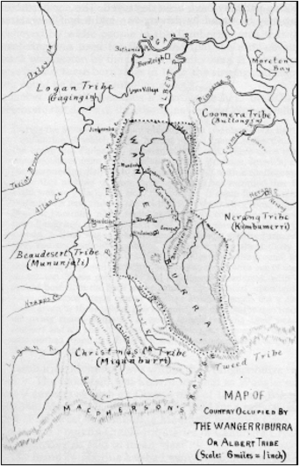Kombumerri clan facts for kids
The Kombumerri clan are one of nine special groups of the Yugambeh people. The name refers to the Aboriginal people who traditionally lived in the Nerang area on the Gold Coast, Queensland, Australia.
Contents
What's in a Name?
The name Kombumerri comes from a Yugambeh word, gūmbo. This word means a type of shellfish called a mudflat or cobra. These "cobra" shellfish were a tasty food for Aboriginal people. The word -merri means "man," so Kombumerri means "cobra people."
We don't know the original name the Nerang people used for themselves. The name Kombumerri was first written down in 1914. This happened when a man named John Allen, who was from the Wangerriburra group, worked with a schoolteacher. Allen said that Kombumerri was the name for the people of the Nerang River.
Other names have been used too. In 1923, a man named Archibald Meston said the Nerang group was called the "Talgiburri." This name might mean "people of the dry forest." Meston also mentioned another group called the "Chabbooburri."
Another name for the Nerang River group was Nerang-ballun. The word nerang itself has a few possible meanings. It could mean "little stream" or be related to a type of shovel-nosed shark.
Language Spoken
The Kombumerri people spoke a special way of talking, or a dialect, from the Yugambeh–Bundjalung languages. About 500 words from their language have been saved.
Experts like Terry Crowley believe there were two main ways of speaking in this area. One was Ngarangwal, spoken between the Coomera and Logan rivers. The other was spoken between the Nerang and the Tweed. These languages were very similar to each other.
Traditional Lands
The Kombumerri people's traditional lands stretched far and wide. To the north, their country reached the Coomera River. To the south, it went as far as Tallebudgera Creek. To the west, their land extended into the Gold Coast hinterland.
Maps from the past show that the Kombumerri lived south of the Bullongin group. They were also north-east of the Tweed group. The Wangerriburra people lived in the hills to the west of the Kombumerri.
Dreamtime Stories
A special story about a hero named Gowonda comes from the Nerang area. Gowonda was a white-haired hunter who was very good at training dingoes to hunt. He was especially connected to Southport.
When Gowonda passed away, his people were very sad. One day, children were playing on the beach near the Nerang River. They saw Gowonda in the waves! He had been changed into a Dolphin in the Dreamtime. They saw him teaching other dolphins to push fish onto the beach. This helped his people catch fish easily.
The Aboriginal people believed that any dolphin leader with a white fin was a descendant of Gowonda. Because dolphins helped them so much, the Kombumerri people never hunted them.
Some people thought this special way of fishing with dolphins only happened in one place. However, old records show that this custom was actually common along the Queensland coast for a long time.
Early Encounters with Settlers
In 1842, white settlers first came into the Nerang area. They were looking for valuable cedar trees. Two young men, Edmund Harper and William Duncan (who was 14), explored the Numinbah Valley.
These two young men became friends with the local Aboriginal people. They learned to speak the languages of the Tweed and Nerang groups so well that the Aboriginal people couldn't tell they weren't from the tribes.
Harper and Duncan later returned to the area. William Duncan started working in the district in 1848. He and other timber workers set up their first camp in the Numinbah Valley. Duncan's sons later shared important Aboriginal history with a researcher named J.A. Gresty. Another man, Fred Fowler, also learned the Nerang language and wrote down some words.
Edmund Harper married an Aboriginal woman from the Nerang area. They had a son named Billy. Around 1870, Archibald Meston estimated that about 200 Aboriginal people lived along the Nerang River.
Important Places
There are many important places for the Kombumerri people on the Gold Coast. Burleigh Heads, Queensland is a very special mountain. It is considered a "sacred women's area" for the Kombumerri people and their ancestors.
Not far from this sacred mountain is the Jebribillum Bora Park. This park is a "men's area" and is also very important.
In 1963, a burial site was found at Broadbeach. This site was unknown to the local Aboriginal people. An archaeologist named Laila Haglund carefully dug up the area. She and her team found the remains of about 150 people. In 1988, the bones were respectfully reburied in a nearby park at Broadbeach. A special plaque was placed there to remember them.
Well-Known People
Mary Graham is a philosopher who has both Wakawaka and Kombumerri family roots. She has written about the deep ideas and ways of thinking of Aboriginal people.
Other Names for the Kombumerri
- Chabbooburri
- Dalgaybara
- Nerang tribe
- Nerang-ballun
- Talgiburri
Some Words from the Language
- beeyung (father)
- duckering (whiteman)
- groman (kangaroo)
- nogum (tame dog)
- uragin (wild dog)
- wyung (mother)
Source:
See also


